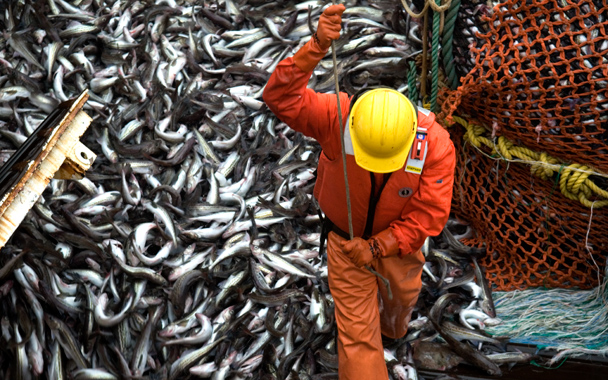Dark Days for the Other White Fish
You’ve probably eaten Alaska pollock without knowing it: Alaska has the world’s largest pollock fishery, and pollock is rarely served under its own name; because its mild-tasting white flesh is so neutral, the species is found in everything from fake crabmeat to fast-food fish sandwiches to fish and chips to frozen fish sticks.
And it is supposedly sustainable, having met the high standards of the Marine Stewardship Council.
But late last week, Greenpeace issued a warning claiming that after years of fishing pressure and poor survival rates of juveniles, the pollock population has dropped by 50 percent since last year to its lowest level on record. “We are on the cusp of one of the largest fishery collapses in history,” John Hocevar, the director of Greenpeace’s Oceans Campaign, told The Seattle Times.
The fishery, which relies on huge trawlers, came under fire as a possible culprit in the collapse of the king salmon run in the Yukon River. Salmon, which are valuable as both subsistence food and a source of cash for local natives, are caught in pollock nets as by-catch. There is also concern that overfishing of pollock is depriving whales, fur seals, and endangered Stellar sea lions of a critical food source.
There is a glimmer of hope. In December, the North Pacific Fishery Management Council will set catch limits for 2009. Greenpeace says they should be half of the 2008 level, but notes that the council is dominated by industry representatives. Let’s hope they put the long-term health of Alaskan pollock populations before short-term profit.
A Few Bad Eggs
Free-range, cage-free, all-natural, organic, United Egg Producers Certified . . . It’s not easy for a conscientious consumer to buy a dozen eggs these days.
And according to the Humane Society of the United States, some of the confusion may be a direct result of actions taken by large egg producers and the industry’s leading trade association.
Last week, the Washington, D. C.–based animal welfare group sued two large producers—Moark, LLC, and R.W. Saunder, Inc.—as well as the United Egg Producers (UEP), whose members include 95 percent of the nation’s egg farmers. The suit claims that the UEP certification program misleads consumers and amounts to false and deceptive advertising about the “deplorable” conditions hens endure. (For instance, UEP claims that its certification “provides assurance that hens receive adequate space,” yet it requires that each hen be allotted 67 square inches—a smaller area than a sheet of writing paper.)
The suit comes at a time when Californians are set to vote on a state proposition that would prohibit close confinement of farm animals. Mitch Head, a spokesman for the Egg Producers, dismissed the Humane Society suit as being motivated to affect the California decision. “It’s just harassment and political dirty tricks,” he told a reporter.
So what is the conscientious egg buyer to do? A United States Department of Agriculture “Organic” seal means that hens must be cage-free and have access to the outdoors, but there are no regulations governing the amount and type of access. Certification by groups including Humane Farm Animal Care, Animal Welfare Institute, and American Humane Association assure that chickens are provided with adequate living space to at least scratch, flap, and turn around.




 Pinterest
Pinterest


